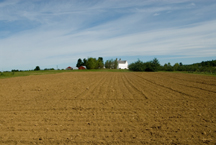Agriculture & Water Quality
 New England has a long history of agricultural production. Dairy and beef, vegetables, potatoes, and grains continue to shape the landscape and provide millions of dollars to states that have since become predominantly service-based economies. While the number of dairy farms has dropped in recent years, the amount of milk produced in New England has remained reasonably constant.
New England has a long history of agricultural production. Dairy and beef, vegetables, potatoes, and grains continue to shape the landscape and provide millions of dollars to states that have since become predominantly service-based economies. While the number of dairy farms has dropped in recent years, the amount of milk produced in New England has remained reasonably constant.
Extension and Ag Experiment Stations provide dairy producers with answers for their production questions. With the intensification of livestock based agricultural systems, there has been an increase in soil nutrient levels, particularly phosphorus.
In all New England states, Extension staff are providing growers with research-based information on nutrient budgeting, in-season soil and plant tissue testing, and other means to ensure that they are maximizing efficiency of their nutrient programs. Applied research is being conducted in New Hampshire and Vermont to determine adequate buffers to protect water quality. In Maine, potato growers are conserving water and soil resources by improving soil quality through longer potato rotations and using manure for nutrients and mulches to hold soil moisture in the growing season. Liquid manure has proven to be a valuable nutrient source that can increase available water for potatoes and does not increase the risk of pathogens. Finally, we have had some significant decreases in pesticide use in potato production through improved disease forecasting, and through improved weed and insect management systems.
Today in New England, with the drop in milk prices and increasing demand for organic production, there is increasing interest in organic production systems. So, with this comes an increasing need for non-chemical based weed control and nutrient management information. As we look to the future, integrated research and Extension programs will continue to be an essential component of sustainable agriculture in New England.
